Beginning Again
Back in Panama City and in a different room at Hotel Central.
After another beautiful, fruit-filled breakfast, the day began with a welcome briefing to the whole group by Roberto in the conference room. An introduction around the table revealed a jolly bunch of fellow travelers from all over the U.S., some of whom had done DOZENS of O.A.T. (Overseas Adventure Travel) trips!
We took a quick orientation walk around Casco Viejo near the hotel and then a longer walk to where the buses were allowed to park. Here we re-met José 1 (we were to meet and rely on at least two other Josés on the trip).
José took us to La Vieja - UNESCO World Heritage Site - the site of the original Panama City founded by the Spanish in 1519. Panama City was the pivot point for further Spanish conquest of South America and a warehouse/transfer point for the gold plundered from the south onto ships headed back to Spain.
Rich in historical narratives, we were told that the pirate Henry Morgan sacked the city in 12 hours with only 2000 men who walked the 50 miles from the Caribbean port of Colon (roughly along the path of the now Panama railway) and attacked from the unguarded land side of town. The Governor tried to save the city from Morgan by burning the stored gunpowder, but only succeeded in burning down the whole city! Ooops!
It’s not recorded whether Morgan offered his thanks…
While at the ruins of La Vieja, we toured the modest museum, some climbed the tower and all were impressed by the ruins of the neighborhoods devoted to the Jesuits, the Augustinians and the Dominicans.
Back on the bus and the walk back to Casco Viejo and a delightful lunch at René’s Restaurant, a family-run, three-table gemstone eating establishment. Corvina (sea bass) and salad - yum.
A short rest and our family headed over to the Panama Canal Museum located next door to the hotel. No photos allowed in the main exhibit part, but the special show on molas was camera-friendly.
Later, Roberto took us on our first “Controversial Topic” tour just to the edge of the posh Casco Viejo where we met a gentleman who had spent his whole life in this neighborhood of now hollow shells protected by fierce signs and razor wire. This soft-spoken man related how the landlords let the properties deteriorate to a deplorable level after 1989 and cut a deal with UNESCO to rebuild and repair with affordable housing. That never happened, so building after building was sold to developers who made pricey condos that none of the former residents could afford.
This man and 60 others took refuge in a condemned school where they live as a struggling community today. Neither UNESCO nor the Panamanian government has done anything to help these and thousands of others living on the fringes of the very upscale Casco Viejo.
Tonight we ate at Milano’s with Mary, Cullen, Shirley, Balu and Roberto. The musical entertainment during dinner was decidedly better being provided by a professional violinist named Luis Miguel Gonzalez (https://www.youtube.com/watch?v=woM0XU9Y_mQ). The guy and the ceviche were PRIMO!
View from our balcony.
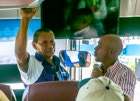
Roberto introduces the whole group to José 1 who will be our bus driver for almost the whole trip.
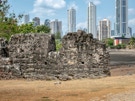
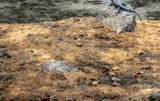
A Jesus Christ Basilisk Lizard. No foolin’, that’s his name!
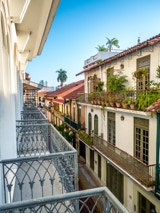
A bit of a contrast between the old Panama City and the new Panama City, no?
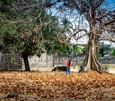
We are loving these ancient trees, so different from the ones we know.
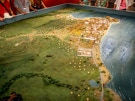
We tourists lined up around this model of the original town layout of Spain’s Panama City. Note the fortifications all along the beach, but nothing to resist attack from the land side.

The Brownea Coccinea (Rose of Venezuela) Flame tree frames the ancient tower at La Vieja. We timed this blooming beauty at just the right time!
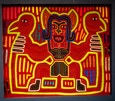

The mola show on the top floor of the Panama Canal Museum was spectacular.

The exhibit featured a wider range of examples than we had ever seen.
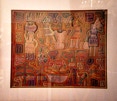
Here is our mola that got us started. It is a very old one offered for sale at Colorado College after a special show by a local collector of molas. It’s called “Womans Work”.


The cathedral altar. Real gold liberated from South American conquests by the righteous Spanish conquerers?
As a bonus, Cathy got a free ride down from the exhibit via a stair chair.
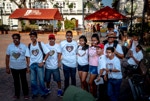
Our afternoon walk brought us in contact with these teens who were soliciting donations in support of kids who have Downs Syndrome. Roberto stopped, bought WAY too many lollipops from them and had us take their group photo. It obviously made their day. What a nice gesture!


Laundry hanging in the gymnasium of the condemned school where 60 folks have taken refuge due to gentrification of their neighborhood.
Omar Efraín Torrijos Herrera, dictator of Panama from 1968 to 1981. He is best known for negotiating the 1977 Torrijos–Carter Treaties that eventually gave Panama full sovereignty over the Panama Canal.

A street photographer and his model on the streets in Casco Viejo.
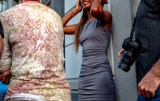


The sign to the right says: “These are the ruins of the Jesuit temple and convent. A schools was built on the grounds in the 18th century which 8 years later became the first university on the Isthmus of Panama. It functioned until 1767, when the Jesuits were expelled from all Spanish lands. The church was built after 1749, and it was most likely never completed. The building burned in 1781 and an earthquake in 1882 affected it even more.
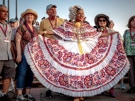

On the stairs in Las Bovedas, a woman models a Pollera traditional dress about which you will learn a lot more later.
Obelisk with rooster at the Institute of National Culture.

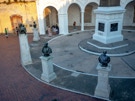
Statues at the base of the obelisk.
Sun sets on the southernmost tip of Casco Viejo.

Looking back across the gentrified neighborhood of Casco Viejo at sunset with the Cathedral Basilica of St. Mary in the background.

The tide is out, and the Bridge of the Americas is in the deep background beckoning us to travel the Panama Canal. Just wait a few days…